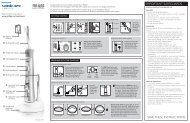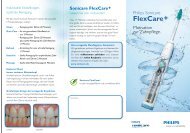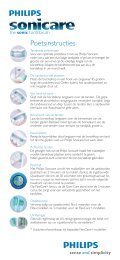Philips Sonicare FlexCare - Sonicare.com - Sonicare
Philips Sonicare FlexCare - Sonicare.com - Sonicare
Philips Sonicare FlexCare - Sonicare.com - Sonicare
You also want an ePaper? Increase the reach of your titles
YUMPU automatically turns print PDFs into web optimized ePapers that Google loves.
tinuous variables. Analysis of the primary end point,<br />
including parameter and confidence interval estimation,<br />
was ac<strong>com</strong>plished using statistical software<br />
S-PLus 7.0. c The repeated measures crossover data<br />
were analyzed using a linear mixed effects model. 20<br />
Subject mean plaque scores obtained by averaging<br />
overall sites corresponding to a single subject on a<br />
given visit defined the <strong>com</strong>putational unit in statistical<br />
tests. Comparisons between groups were performed<br />
using the appropriate F test. Analyses were<br />
carried out for full mouth, anterior region, posterior<br />
region, interproximal sites, and interproximal sites<br />
of posterior region.<br />
Results<br />
Two of the 89 subjects initially enrolled were<br />
lost to follow-up. The 87 subjects who <strong>com</strong>pleted<br />
the study and qualified for the ITT analysis constitute<br />
the study sample discussed below. Study population<br />
demographics are shown in Table 1. Subjects<br />
exhibited moderate-to-high average plaque scores<br />
(median TMQH, 3.17) at the screening visit after a<br />
24-hour abstinence from oral hygiene.<br />
Efficacy data for the primary out<strong>com</strong>e variable<br />
(overall percent reduction) and information<br />
obtained on subcategories are presented in Table 2<br />
and Figure 2. Subjects using the <strong>Sonicare</strong> <strong>FlexCare</strong><br />
model achieved a statistically significantly greater<br />
c<br />
S-Plus version 7.0, Insightful Corporation; Seattle, WA.<br />
percent reduction (P = .0039) in full-mouth TMQH<br />
scores than Elite 9000 users. A similar out<strong>com</strong>e was<br />
observed in the anterior region (P = .0013), posterior<br />
region (P = .0182), interproximal surfaces (P =<br />
.0003), and posterior interproximal surfaces (P =<br />
.0082). With both devices, the largest plaque score<br />
reduction was observed in the anterior region, which<br />
includes canines and incisors.<br />
Treatment effect estimates presented in Figure 3<br />
confirm that the <strong>Sonicare</strong> <strong>FlexCare</strong> model was more<br />
effective in reducing plaque score than the <strong>Sonicare</strong><br />
Elite 9000. The largest effects were seen in the anterior<br />
region (4.5%) and at interproximal surfaces<br />
(4.1%). The effect was somewhat smaller in the posterior<br />
region, which includes all bicuspids and<br />
molars (2.5%). All effect estimates were statistically<br />
significant favoring <strong>Sonicare</strong> <strong>FlexCare</strong> over <strong>Sonicare</strong><br />
Elite.<br />
The only dental adverse event reported during<br />
the study concerned a gingival abrasion in a subject<br />
assigned to the <strong>Sonicare</strong> Elite 9000. The examiner<br />
determined that it was possibly related to treatment<br />
and mild in severity. The lesion resolved spontaneously<br />
within 6 days.<br />
Discussion<br />
The present study provides the first published<br />
clinical evidence that the new <strong>Sonicare</strong> <strong>FlexCare</strong><br />
toothbrush is highly effective in reducing dental<br />
Figure 2—Percentage reduction of Turesky Modified Quigley-Hein (TMQH) plaque index scores<br />
Plaque<br />
reduction<br />
(%)<br />
50<br />
40<br />
30<br />
41<br />
47<br />
42<br />
37 37 37<br />
34<br />
33 33<br />
31<br />
<strong>FlexCare</strong><br />
Elite<br />
20<br />
10<br />
0<br />
Overall<br />
Anterior<br />
Posterior<br />
Interproximal<br />
Posterior<br />
interproximal<br />
The bars represent mean percent TMQH score reduction (100% × [(prebrushing score – postbrushing score)/prebrushing score]).<br />
26 Compendium / September 2007 Vol. 28, No. 9 (Suppl 1)










